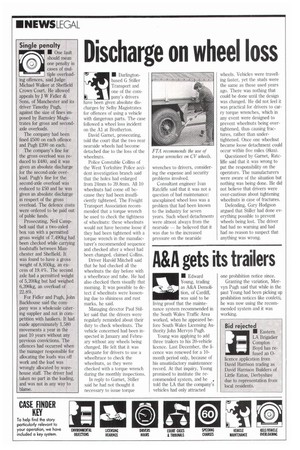Discharge on wheel loss
Page 18

If you've noticed an error in this article please click here to report it so we can fix it.
Ii • Darlington
based G Stiller Transport and one of the com pany's drivers have been given absolute discharges by Selby Magistrates for offences of using a vehicle with dangerous parts. The case followed a wheel loss incident on the Al at Brotherton.
David Garnet, prosecuting, told the court that the two rear nearside wheels had become detached due to the loss of the wheelnuts.
Police Constable Collins of the West Yorkshire Police accident investigation branch said that the holes had enlarged from 24nun to 39.8mm. All 10 wheelnuts had come off because they had been insufficiently tightened. The Freight Transport Association recommended that a torque wrench be used to check the tightness of wheelnuts: these wheelnuts would not have become loose if they had been tightened with a torque wrench in the manufacturer's recommended sequence and checked after a wheel had been changed, claimed Collins.
Driver Harold Mitchell said that he had checked all the wheelnuts the day before with a wheelbrace and tube. He had also checked them visually that morning. It was possible to detect if wheelnuts were loosening due to shininess and rust marks, he said.
Managing director Paul Stiller said that the drivers were regularly reminded about their duty to check wheelnuts. The vehicle concerned had been inspected in January and February without any wheels being changed. He felt that it was adequate for drivers to use a wheelbrace to check the wheelnuts, as they were checked with a torque wrench during the monthly inspections.
In reply to Garnet, Stiller said he had not thought it necessary to issue torque wrenches to drivers, considering the expense and security problems involved.
Consultant engineer Ivan Ratcliffe said that it was not a question of bad maintenance: unexplained wheel loss was a problem that had been known to the industry for seven years. Such wheel detachments were almost always from the nearside — he believed that it was due to the increased pressure on the nearside wheels. Vehicles were travelling faster, yet the studs were the same as those used years ago. There was nothing that could be done until the design was changed. He did not feel it was practical for drivers to carry torque wrenches, which in any event were designed to prevent wheelnuts being overtightened, thus causing fractures, rather than undertightened. Once one wheelnut became loose detachment could occur within five miles (8km).
Questioned by Garnet, Ratcliffe said that it was wrong to put the responsibility on the operators. The manufacturers were aware of the situation but nothing was being done. He did not believe that drivers were over-cautious about tightening wheelnuts in case of fractures.
Defending, Gary Hodgson argued that Stiller had done everything possible to prevent wheels being lost. The driver had had no warning and had had no reason to suspect that anything was wrong.
















































































